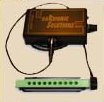| Frequency Response : The frequency response determines
how a given frequancy will be transmitted by the microphone to the amplification
equipment. They are often drawn on the technical specs of mics and look like gaussian
curves (with a hump in the middle). To be perfectly honest, there is very little you can
learn by just looking at the curve unless you're an expert in electronics and sound. So as
a rule this criterion, although technically important will not help you to choose.
Therefore we will not keep it in the recap table below. Impedance :
Impedance is not so much an element of choice as a constraint you need to be aware of.
It's a measure of resistance in the use of electrical currents. PAs
are Low impedance (less than 200 ohms) which allows for longer cable lengths without sound
loss whereas amplifiers and effect pedals are High impedance. As a rule, when the plu into
which you insert the cable is a 6,35 jack it's very likely to be high impedance; when the
plus is a 3-pin XLR, it's always low impedance. Make sure that the elements you link
together have the same impedance or you'll suffer volume and quality losses. Most vocal
microphones are sold for low impedance since their plug is an XLR. Some of them can be
switched to high impedance. In any case you can easily find impedance transformerswho
often allow you to switch from one to the other.
Output Level : A good output level pretty much guarantees a powerful
sound. It also pretty much guarantees excessive saturation or feedback. Again, figures are
insufficient to judge, all depends on what you're looking for. On top of that this
information doesn't always appear on technical specs. We won't keep this criterion either
for those reasons.
Weight : For comfort of playing and ease of transportation, this is a
relevent criterion.
Volume pot : Some players like to have a volume pot that allows them
to boost their output when needed and also to counter incoming feedback by lowering the
volume level.
Switch on/off : A switch allows you to cut out the mic completely when
it's not in use to minimise the risk of feedback or extraneous noises.
Elements : Some microphone manufacturers propose several different
elements inside their microphones (the element is sometimes also called capsule and it's
the part that react to the sound and carries it over.) Different elements have different
sound textures. When several elements are available we marked Yes in the Elements column. |
 haRmonic Solutions haRmonic Solutions
While working on this test we discovered another interesting product that
is not a microphone as such but does allow harmonica amplification since it's a pre-miced
harmonica.
Richard Smith is the English gentlemen who builds this product and he
told us that several harmonica players from Britain including Johnny mars and Adam Glaser
have already adopted his system
We have briefly tested the system and it sounds promising. Unfortunately
the harmonica on which the microphone had been incorporated wasn't to everybody's taste,
which didn't allow us to take full measure of the product's capabilities. That being said,
Richard also proposes to mount the microphones on any existing harmonica model, which
allows each player to go on playing his favourite ole harps.
Richard also designs hand-held mini-mics similar to the Honker or Madcat.
For more information on his solutions, go to his website :
haRmonic
Solutions |